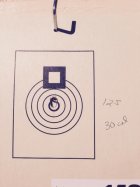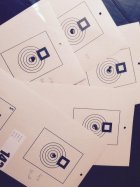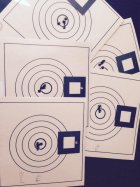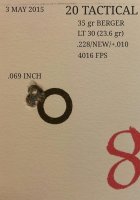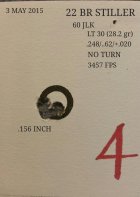I have been playing with LT30 in a 6PPC and with very light (35 gr.) Nosler lead free ballistic tips in a .222.
In the PPC the charges are well down in the case (into the shoulder of the case) when I hit top pressures with 65 grain bullets, but the powder seems to burn pretty well in spite of that. I do not think that it is a important for the case to be nearly full with this powder as it may be with others.
The reason for the light bullets in the .222 is that in California we have to use lead free bulllets for hunting in many areas, and I have a couple of 14" twist .222s. That twist is too slow for heavier lead free bullets because they are longer for any weight because of their less dense construction. I had thought that my varmint rifle would become obsolete for this reason, until a friend pointed out that the .22 cal. 35 grain bullets have a BC of .201 which is not that much less than that of the 40 grain lead core version that along with the same weight of Vmax had become my favorite bullets in that caliber, before concerns for the California Condor, and the resultant lead bullet ban came along.
Having been gifted with a writer's sample of LT 30 by Western Powder, I contacted Nosler for some samples of the lead free bullets and at that point was all set, waiting for a suitable day to go to the range and do some loading and shooting over the chronograph. Although I have more work to do with both calibers, I can report one thing that I stumbled across that is worth noting, and some preliminary velocity numbers for the .222.
The particular barrel that I had been working with on the PPC (a Viper actioned 10.5# bench rifle with all the bells and whistles) had been set back full tenon length and rechambered with a .263 neck reamer, which is .001 larger in this dimension than my other barrels, chambered with my personal reamer. For that reason I made some new brass, and changed my neck bushing size by what I had thought was an appropriate amount, but the bullet seating force that resulted was the highest that I had ever experienced in that caliber, quite high. I use arbor press type seaters for that caliber. In any case I thought that that was no big deal since the feel was uniform, and VV133 had been shown to work better with higher seating force.
As it turned out, for other powders this may have had a negative impact on accuracy, keeping me from getting to the accuracy that this barrel is capable of, nothing so bad as to throw up a red flag, but just off enough to be frustrating.
In any case, during one range session with LT 30 I saw some signs of pressure on a couple of cases, and after I got back, had a conversation with a friend that turned on the light.
It seems that he had been shooting LT 30 at an extremely cold winter match and had had some primer pockets expanded to the point where cases were ruined, using loads that had previously shown no signs of problems. This had been some time before, and he had not mentioned that he had discovered the reason. After my experience, which had not ruined cases but was somewhat of a mystery, he happened to mention that he had discovered what the problem had been....excessive neck tension, that when he brought that down to a lower level, that the problem did not occur, and the accuracy was excellent. His tests before the match had been with cases that were freshly turned, and because their necks had been opened slightly by the expanding mandrel, they had less tension than at the match. Like me he had probably been on the high side, although probably not as high as I had been, because he had normally been shooting 133. In any case, reducing neck tension solved his problem, and the powder shot very well, as it had before he went to the match.
After that, I told the story to a friend who is a very experienced benchrest shooter, and he told me that for all of his shooting with his 6PPCs, with powders other than 133 he uses neck tension that is so little that he can almost move seated bullets with his fingers, and the man can shoot, so I took him at his word.
Getting back to my range session, after I had had a problem with LT 30 (that, as it turned out was a loader, and not a powder problem) I switched to LT 32 and decided at the same time to do something about the extremely high seating force. This took me up .002 in bushing inside diameter to get to the light feel that I had decided to try. At that point, the accuracy got extremely good, just as I was getting ready to leave. (It was later the same day that my friend had told me about his neck tension issue.)
So...the next time I go to the range I have my work cut out for me, retesting LT 30, and for that matter my other non 133 powders with light tension, and based what I have learned, and seen in a very small sample, I expect the results to be excellent.
Returning to the .222 for a bit, I was able to work up to a load with the 35 gr. Noslers that exceeded 3,800 FPS ( probably well above manual pressures) before pressure signs stopped me, this from a 22" Hart barrel with a zero freebore tight neck chamber. I thought that interesting. MY next step with be to do some testing with my varmint rifle that had a factory barrel, to see if its bore dimensions, which have proven to be more critical for no lead bullets, are workable. In the past, with lead core bullets, its accuracy has been very good for a factory rifle, but those bullets slug up better than I have been told lead free do, which is why I need to do the test.
For both calibers, the powder burned cleanly, cleaning up relatively easily.
The take away from this is that if you are going to get the most from this powder, I suggest that you go light on neck tension, and with that, expect excellent results when it is paired with bullets of appropriate weight for its speed.
Time will tell, but based on my friend's experience, I believe that even though it was billed as a .30 BR power, and does not fill the case with normal bullet weights in a 6PPC, that it may turn out to be a very good powder in that caliber. I am looking forward to my next range session.










